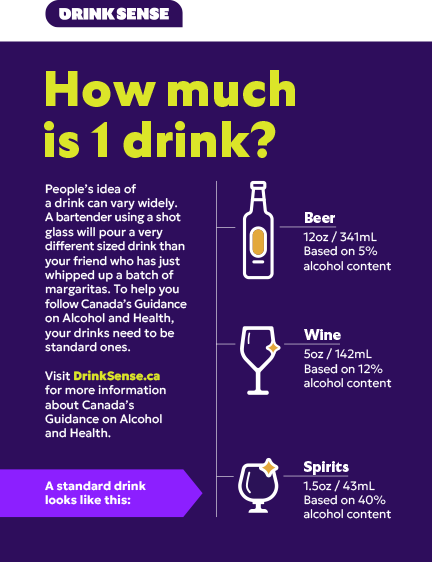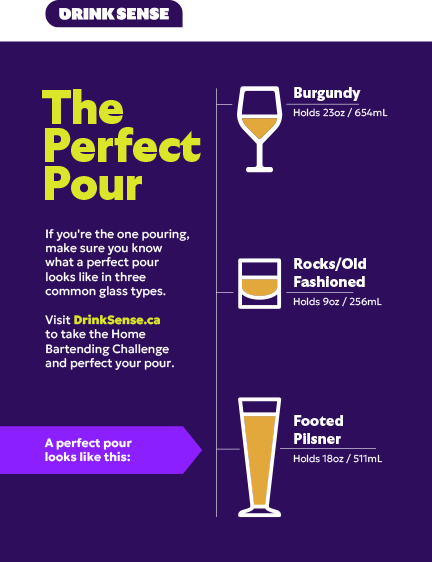Memorable Nights. Incredible Mornings.
Sure, you can have a couple. And if you follow Canada’s Guidance on Alcohol and Health, you can create a lifestyle that includes alcohol, non-drinking days and overall balance. If you want to feel rested in the morning and have more energy during the day, following the Guidance on Alcohol and Health can help you get there.
Canada’s Guidance on Alcohol and Health, based on scientific evidence, offers Canadians the information needed to make well-informed and responsible decisions about their alcohol consumption.
Here’s a quick look:
There is a continuum of risk associated with weekly alcohol consumption where the risk of harm increases with each drink consumed. To reduce the risk of harm from alcohol, it is recommended that people living in Canada consider reducing their alcohol use.
Read Canada’s Guidance on Alcohol and Health

View the 30 second commercial
So what's a drink?
People’s idea of a drink can vary widely. A bartender using a shot glass will pour a very different sized drink than your friend who has just whipped up a batch of margaritas.
To help you follow Canada’s Guidance on Alcohol and Health, your drinks need to be standard ones. A standard drink looks like this:


Beer: 12oz or 341ml based on 5% alcohol content
Wine: 5oz or 142ml based on 12% alcohol content
Spirits: 1.5oz or 43ml based on 40% alcohol content
If you're the one pouring, take the Home Bartending Challenge and see how your skills measure up when it comes to serving a standard drink.
All Drinks are not Created Equal | Alcohol Content
Even the same type of drink in the same amount might be more than a standard drink because of alcohol content. Take beer, for example. The alcohol content can vary from 1.1 to 11 percent and up. That means the same amount of beer may or may not be equal to one standard drink (17 ml of pure alcohol).

X-TRA LIGHT: 12oz/341ml | 1.1% - 2.5% alcohol | 2.5% ~ .3oz/9ml pure alcohol
LIGHT: 12oz/341ml | 2.6% - 4% alcohol | 4% ~ .5oz/14ml pure alcohol
REGULAR BEER: 12oz/341ml | 4.1% - 5.5% alcohol | 5.5% ~ .7oz/19ml pure alcohol
STRONG: 12oz/341ml | 5.6% - 8.5% alcohol | 8.5% ~ 1oz/29ml pure alcohol
X-TRA STRONG: 12oz/341ml | 8.6 % alcohol+ | 11% ~ 1.3oz/38ml pure alcohol
Try a Mocktail
Consider skipping the chaser and trying a spacer - a non-alcoholic or low alcohol drink that you have in between alcoholic ones.
How about whipping up one of these mocktails as your spacer? Watch the videos below for three delicious recipes and step-by-step instructions or check out our full library of Featured Mocktails.
The Real Deal on Alcohol | Myths and Facts
There’s a ton of information out there about drinking. Some of it’s accurate, some of it not so much. Here you’ll find some common myths about alcohol…and the facts.
Keeping it Social │ Drinking Within the Guidelines
Looking for some ways to help you follow Canada’s Guidance on Alcohol and Health? Here are some tips that can help.
Eat while you drink.
Snack often, before and while you drink, to slow down how fast your body’s absorbing the alcohol being consumed. Your stomach will thank you in the morning. (Your head might too.)
A standard drink size matters.
Who says size doesn’t matter? Stick to a standard pour and take a pass on top ups so you know how much you’re really drinking.
Water is your friend.
Drink more...water, that is. Alcohol dehydrates you. Try a glass of water in between each drink.
Sip slowly and savour.
Chugging’s for amateurs. Sip slowly and savour. Enjoy your wine’s aroma and the taste of that single malt. And if you have a couple of non-drinking days each week, like the guidelines recommend, you might just have the extra funds to splurge on some top shelf products.
Choose mixes without caffeine.
Think about taking a pass on alcohol mixed with energy drinks, especially the hand-mixed ones because they usually contain more caffeine than the pre-mixed kind. Why? Because caffeine in energy drinks can mask the effects of alcohol - you might end up feeling like you’re not drunk, but you are.
Combining Alcohol & Cannabis
Alcohol and cannabis might seem like similar products in their ability to provide a relaxing experience, however, combining these products together can pose a risk to users. When cannabis and alcohol are combined, or used within the same session, the effects can be unpredictable. For users of these products, this combination may create the following:
- an increased and unpredictable level of impairment and intensified side effects.
- an increased risk of experiencing short-term harms including injury, poor judgment or worse.
- an increased risk of nausea or vomiting and potentially harmful level of dehydration. Alcohol can act as a diuretic and cannabis has the potential to exacerbate this effect resulting in an increased risk of dehydration.
